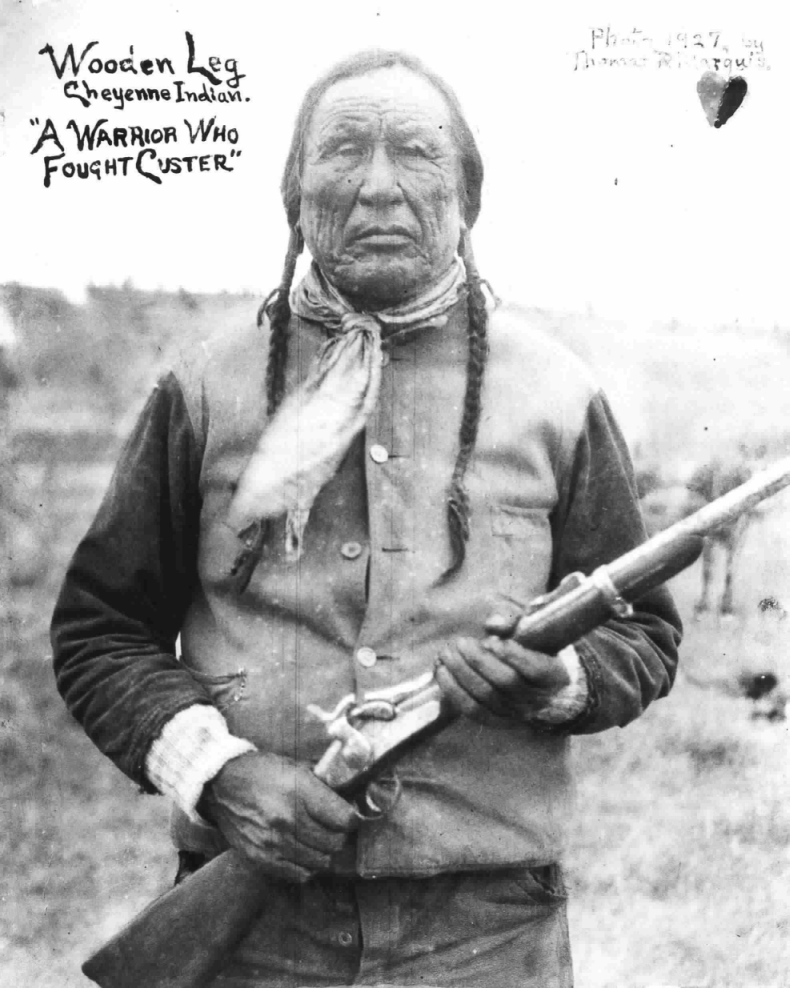On this day in 1906 President Theodore Roosevelt
proclaimed Devil's Tower in Wyoming as America's
First National Monument
Devil's Tower
Crook County, Wyoming
Rising mysteriously above the Belle Fourche River,
this ancient butte composed of igneous rock is located in
the Bear Lodge Mountains, one of the three mountain ranges
of the Black Hills region and national forest, and is in association
with the Black Hills and the Elk Mountains in South Dakota.
The name "Devil's Tower" was said to have been given to
the massive table top rock during an expedition led by Colonel Irving Dodge
of the United States Army, who is said to have misinterpreted the
American Indian name of the structure to mean, "Bad God's Tower".
American Indian tribes who lived in the area had different names
for the "tower" which included, "Bear's Lodge or Tipi" (Cheyenne, Lakota)
"Home of Bears" (Crow) and "Aloft on a Rock" (Kiowa)
Wooden Leg
Northern Cheyenne
According to an old story, a member of the Northern Cheyenne
tribe named Wooden Leg, told of strange goings on at the massive rock as
related to him by an old man while they were traveling past it in the late 1860's.
The elderly man said that an Indian had decided to sleep at the base
of Bear Lodge next to a buffalo head. In the morning, both the man
and the buffalo head had been transported to the top of the rock by
the Great Medicine and had no way to climb down.
He spent another day and night on the top of the rock with
nothing to eat and no water to drink. The poor man prayed all
day to find a way down off the rock and then fell asleep.
When he woke up the next morning he was shocked to find that the
Great Medicine had brought him safely back down to earth again,
however, the buffalo head had been left at the top near the edge.
Wooden Leg claimed that he could clearly see the buffalo head
sitting at the edge of the rock through the old man's spyglass.
How the buffalo head came to rest at the edge of the rock
remains a mystery, for at the time the story took place,
no one had ever climbed up to the top of the rock.
no one had ever climbed up to the top of the rock.
His mention of a buffalo head gives this story a special
significance to members of the Northern Cheyenne tribe.
In each of their camps there was a sacred teepee in honor of
the Great Medicine, which contained objects sacred to the people.
In the culture of the Northern Cheyenne one of the most
sacred of religious objects was the buffalo head.
Rare Ceremonial Buffalo Skull
Northern Cheyenne
The first known white men to climb to the top of the rock
were two local ranchers, William Rodgers and Willard Ripley,
who, in 1903, constructed a ladder of wooden pegs in the rock face.
Hikers along the Tower Trail at the monument can see that
a few of these wooden pegs are still intact and visible today.
Hundreds of climbers from all over the world have since
accepted the challenge and scaled to the top of Devil's Tower.
accepted the challenge and scaled to the top of Devil's Tower.
I believe interest in our first national monument, and especially
the climbing of it, increased tremendously after the release
of Stephen Speilberg's 1977 classic sci-fi thriller,
"Close Encounters Of The Third Kind"
in which the steep rock rising above the plains served
as a landing base for aliens and alien encounters.
The movie also ignited a storm of interest, as well as controversy,
concerning accounts of people gone missing who were believed
to have been abducted by aliens, as well as wild tales of
those who claimed to have been taken by aliens and used
in bizarre medical experiments on board space ships.
"Close Encounters Of The Third Kind"
(1977)
Meanwhile, Devil's Tower and the land surrounding it has always
been considered sacred ground to several Plains Indian tribes,
which include the Lakota, the Cheyenne, and the Kiowa.
The leaders of these tribes have over the years objected to climbers
ascending the monument, considering this as a desecration.
However, due to the fact that "Devil's Tower" was approved by
the United States Congress and designated by Theodore Roosevelt
as a national monument, climbers have argued that they have a right
to climb the it since it is on federally-claimed land.
A compromise was later reached between the government and
the Indian tribes with a 'voluntary' climbing ban during the month
of June, a time when the tribes hold sacred ceremonies around
the monument. Climbers are asked, but not required to stay
off the monument. However, as we so often see in America today,
several climbers along with the Mountain States Legal Foundation
sued the Park Service, claiming "an inappropriate government
entanglement with religion."
An aerial view of the top of Devil's Tower National Monument





No comments:
Post a Comment